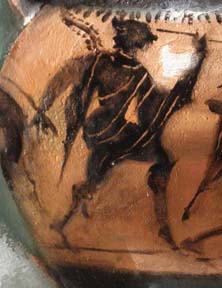 Many attempts and many methods were tried and aborted before this beautiful surface was achieved on my painting, shown above. Initially, I used a wet on wet technique by applying a mixture of yellow ochre, red iron oxide, and white to replicate the actual color of the clay on the Greek vessel. Then, atop the wet surface I applied a mixture of black and burnt umber to create the designs. This became a huge challenge, and I was unsatisfied with the results for days during many re-paintings.
Many attempts and many methods were tried and aborted before this beautiful surface was achieved on my painting, shown above. Initially, I used a wet on wet technique by applying a mixture of yellow ochre, red iron oxide, and white to replicate the actual color of the clay on the Greek vessel. Then, atop the wet surface I applied a mixture of black and burnt umber to create the designs. This became a huge challenge, and I was unsatisfied with the results for days during many re-paintings.
After several attempts and total scrapings, I decided to try a completely different technique. I re-painted the vessel using the same pigments. The colors were applied going from light to dark across the surface adding both highlights and reflected lights. This time, I let it completely dry for a couple of days. At that point, I wet the surface with a medium and used the black/burnt umber combination to draw on the design leaving some areas opaque and others thin to allow the terracotta color to show through. Using this method allowed me to go back with a dry brush and soften the hard edges, especially on the shadowed side of the vessel. It also allowed much easier correction of the drawing.
By adding the burnt umber to the very oily and slow drying black allows the mixture to dry faster without changing the darkness noticeably. After many attempts, I am finally very satisfied with the results. The rich warm tones of the clay against the darks of the design figures allow the vessels to pop forward away from the background which is the optimum goal. In what ways have you had to struggle to get the exact look you wanted on your canvases? For me it is an ongoing challenge.
More to be revealed soon.
